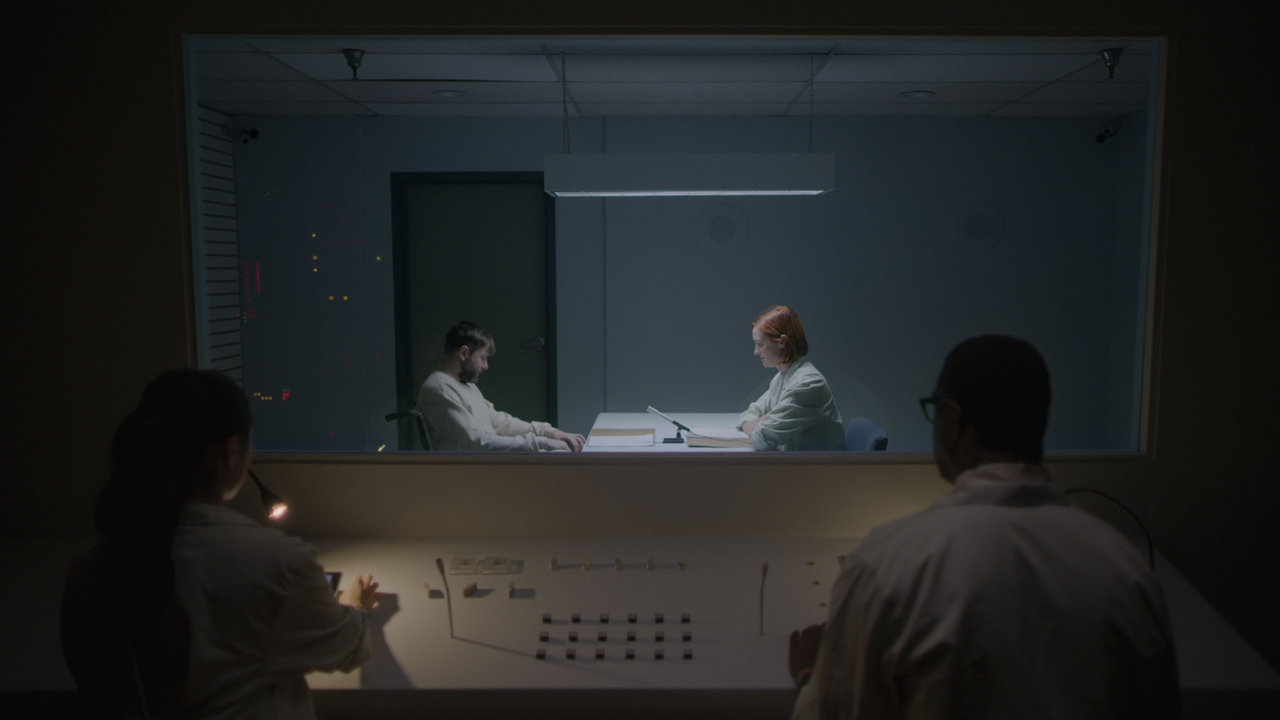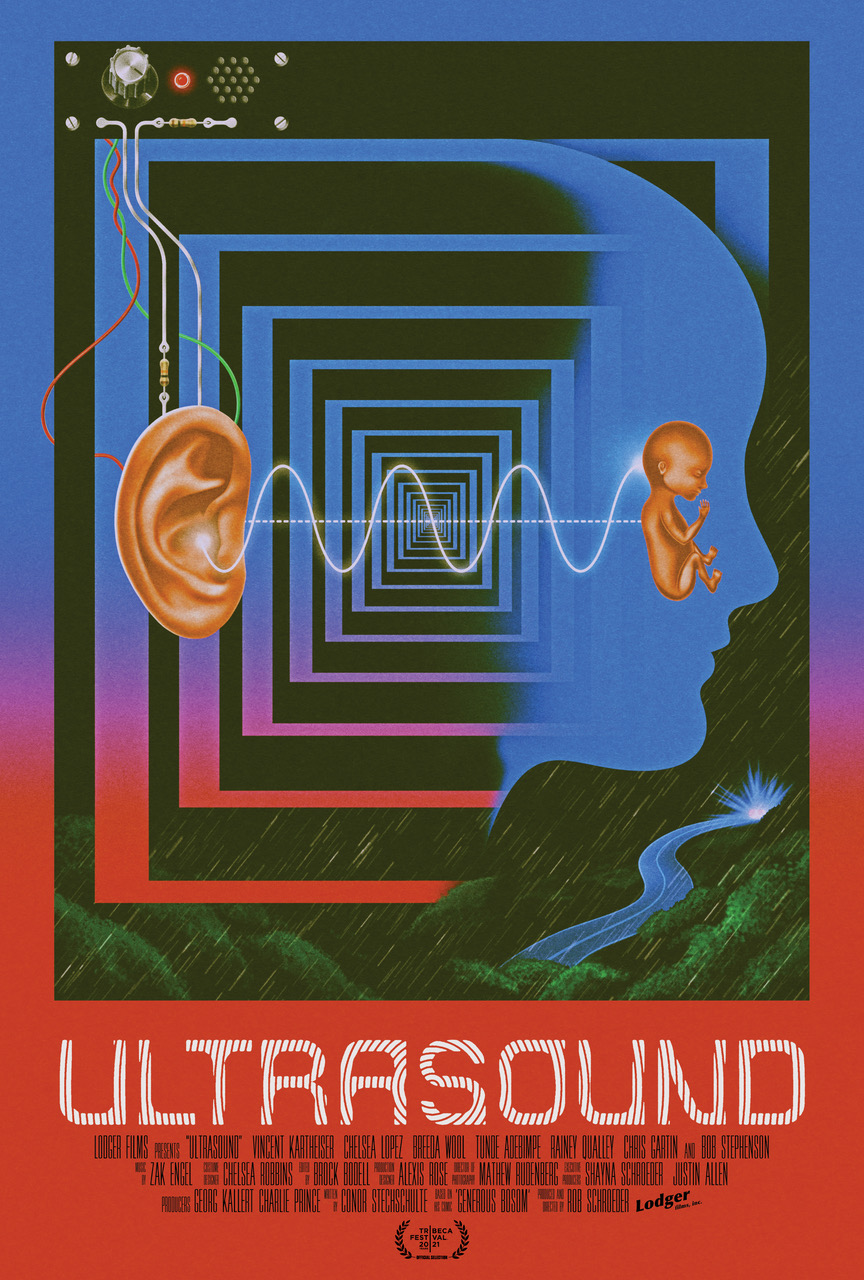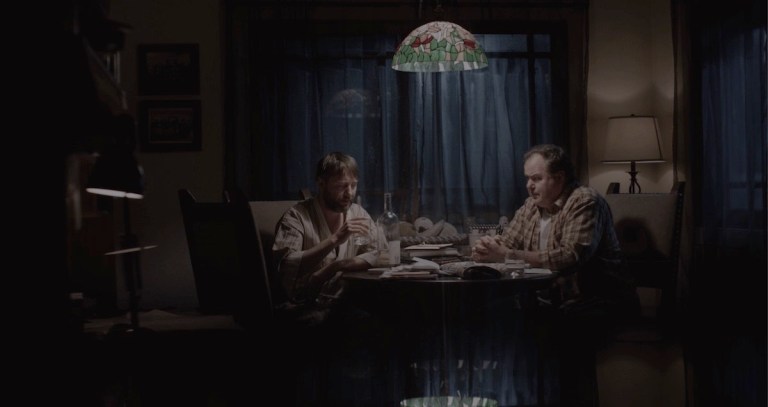
Rob Schroeder delivers one incredible directorial debut with this aesthetically lush and deliciously convoluted mystery box film. After his car breaks down during a storm, our protagonist Glen (Vincent Kartheiser) seeks shelter at the nearby home of married couple Art (Bob Stephenson) and Cyndi (Chelsea Lopez). This strange encounter sets into motion a series of increasingly absurd events while crossing over with the lives of several other characters that, at first, are seemingly unrelated. This includes Katie (Rainey Qualley) who has become pregnant after her affair with a prominent senator seeking reelection and Shannon (Breeda Wool) who has started working at a cryptic research facility. The plot rapidly shifts between these various narratives plunging viewers into a disorienting maze with little sense of time.
That’s just getting you in the door on Ultrasound’s story and honestly, if that intrigues you at all or you love these sort of complex slowly unfolding narratives then you should absolutely stop here and take my word that it’s one damn good film and you will be rewarded the less you know beyond the general synopsis going in for a first time viewing. The story is written by Conor Stechschulte and adapts material from his comic Generous Bosom; which I suspect many will want to seek out after viewing the film. Schroeder has a lot of history as a producer, including serving as co-producer on one of my personal favorite nostalgia throwback style horror flicks of recent years Beyond the Gates, but as a first time directorial feature Ultrasound knocks it out of the park and demands attention for whatever he decides to helm next.

I’ll delve a little further for those interested because there is so much compelling stuff here to discuss but will try to avoid any critical spoilers. If you have a good grasp on your own tastes, you’ll probably know whether Ultrasound will land well for you or not. If you can’t stand a slow-burn narrative that begins, at least, as completely absurd and with storylines perhaps barely connected or relevant to one another then while you may still be able to appreciate all the filmmaking at work it may not be for you. If that is your jam, strap yourself in because it’s a wild ride with a lot of rewarding payoffs. Something that is worth highlighting, if you’re on the fence with these kinds of movies, is the shape of the narrative as the film progresses. Ultrasound strikes an interesting balance between being a completely baffling surreal film and actually unfolding its setup with some unnerving near science-fiction-fueled suggestions. It may contain just one too many “but wait not actually” style twists, but I felt each one was well presented and earned by the narrative.
In the beginning, you get a ton of Lynchian vibes with moments that never seem to make much sense, plotlines that seemingly don’t connect in any logical manner, and awkward out-of-place dialog. I would say the first half felt very reminiscent of some of the best chapters from Twin Peaks: The Return in mood and tone. However, while David Lynch is content to polarize viewers by remaining in the abstract, Ultrasound does begin to unravel its knotted cord and give some revelation to its mystery. As each thread gets pulled, the back half of the film seemed to channel a lot of early David Cronenberg works with their focus on strange and emerging scientific discoveries gone wrong or abused by their researchers, not unlike The Brood or Rabid. There’s even a pretty heavy layer of focus on the nature of perceived reality and potentially altered or implanted memories giving some shades of Videodrome. With the research facility plot and the many well-placed shots of long clinically white endless corridors, I got a bit of Panos Cosmatos’ Beyond the Black Rainbow vibes though Ultrasound never pushes to its glacially paced level of slow burn.
Those are all films I love and once I realized they’re the first examples I would reach for in comparison, I knew Ultrasound was something truly standout. But the film isn’t carried just on its mystery alone. There are several compelling sub-themes that permeate the runtime to leave you thinking. The science-gone-wrong angle is tied up primarily in Shannon’s story as she begins to have doubts about the research they are doing and clashes with the project’s leader Doctor Conners (Tunde Adebimpe). In the midst of one of these arguments while debating the potential involvement of military contractors for funding Connors delivers, in a confident yet unnerving manner, this line, “Unfortunately, for good scientists to survive these days, you have to be a sheep in wolves’ clothing.” It’s a story beat so classic it may have become rote by now for many, but the fact we still find a need to discuss it means that there is something worth questioning there.
Katie’s storyline feels like a pointed look at gaslighting through the lens of horror. Senator Alex Harris (Chris Gartin) has set Katie up in her own apartment and effectively wants her hanging around, but not to contact or be seen with him since his marriage is being effectively leveraged, like any sleazy politician, and he cannot allow an affair to hurt his campaign. Though her segment of the narrative might be less than other characters, Qualley does an excellent job in the role selling Katie’s emotions and the fear and uncertainty that surrounds her. It is hard watching her try to reach out to Alex about her insecurities and see just how callous yet casually he discards her feelings. It’s when the twists start unfolding that this theme really kicks into overdrive and ties up with other characters’ experiences that you realize just how victimized she is by Alex’s machinations.
Truth be told, the entire cast is praise-worthy for their amazing performances across the film. Chelsea Lopez gives some particularly impressive depth as Cyndi who shifts from an oddly lovable girl next door type to shouldering the very overwhelming weight of the trauma she has been put through. When recounting her marriage to Art, she explains to Glen how Art was her high school teacher and that they fell in love and married very young. It’s very emotionally impactful to hear her talk about her regrets and musing over the paths not taken capping off the sentiment by stating, “There’s an energy when you throw away things that people think are important.” While it may only be a smaller part of the bigger picture, this line stayed with me well beyond the end of the film.
Though it may be Bob Stepheson as Art that stands out the strongest of them all. The odd yet seemingly lovable Art rests at the center of every narrative and ends up being the one who ultimately serves as the bridge connecting each story together. When Glen meets him during the opening act, Art comes across as the sort of likable but schlubby down on his luck guy who might helm the family of a sitcom. The fact that he is able to hold this composure even as he casually asks Glen to sleep with his wife without a hint of anything more sinister is both a show of talent and helps with building the awkward surreal tone in the early half of the movie. As the truth gets revealed we learn just what a horrible and frankly abusive monster he actually is making for some excellent contrast in his portrayal.

All that strong character work is backed by rock-solid filmmaking. I wouldn’t say the film quite has a single standout visual style. Instead, perhaps more interesting, there’s a certain pallet stylistically that is built around each storyline going on. While it’s not absolute, much of Glen’s story takes place at night with either muted colors or backed by luminescent neon from various lights in his apartment. Katie’s story opens with her swimming at a pool and makes incredible use of some wide angles and very vibrant underwater shots. With the research facility that Shannon works at we get a lot of stark white colors and plenty of static camera shots. What is even more interesting, however, is the way these unique elements start to bleed through and crash together as the film advances. There’s an incredibly executed chase scene during the climax that brings to mind the sort of cross-reality fading seen in films like Christopher Nolan’s Inception or one of its own points of inspiration Satoshi Kon’s Paprika.
The score, composed by Daisey O’Dell and Rob Lowry, leans heavily on synth work like many other modern horror films. What I appreciated was both its range of tones and the subtlety with which it was employed in the film. The music is moody yet ambient and generally remains subdued in the quieter parts of the film. As we start hitting twist after twist and the stakes escalate, the score ratchets up with some pulse-pounding tracks that really hang with you. During what is arguably the climax of the film as Shannon gears up to take action in light of the many revelations, her preparations are backed by a great piece of music that feels like it was torn from pages of Trent Reznor’s efforts in film scoring.
It’s hard not to talk about the sound design either. To stay as vague as possible, auditory sounds and various tones play a central role in the film. You experience this from the start, but don’t get the context to actually understand it until much later. We’re given some more upfront context for this theme in Shannon’s story as she appears to be using some form of binaural beats styled recordings as a form of self-therapy. The way a particular sound can sit almost hidden within the mix and then surge to fill up and overwhelm the entire scene is impressive and helps underscore the more science-fiction leaning concepts that the film tries to wrestle with.
I simply cannot stop praising this film and picking out all the little bits that I loved. There is so much more I want to dig in with. But there’s a much greater payoff to not having it spoiled, so unfortunately those discussions are better saved for another time. Once you know all the twists, there is a feast of captivating themes and ideas to mull over and consider. Fans of this style will likely desire and find even greater reward in revisiting the movie subsequent times to analyze and dig even deeper. The ending leaves a deliciously wicked final sting that hits into the category of films like Inception where things are never quite so cleanly tied up and there is a lot of room left for speculation and personal interpretation.
You shouldn’t rely on my hype alone, however. I know these types of films wind up being highly polarizing. Even as I’m desperate to watch it again and look for any subtle clues or hints that I missed, others are going to walk away feeling like they wasted their time or that it was a slow burn that never amounted to anything. That’s not to make any criticism about taste or whether someone “understood” the plot or not. I think by design this style of film plays incredibly effectively to those that can jam on its same wavelength, but it’s going to fall short for those who can’t and there’s nothing wrong with that. Ultrasound is an incredibly complex meticulously designed mystery box of a film that offers an incredibly rewarding experience for those willing to wander the labyrinthine halls of its world.
Ultrasound was screened as part of the 2021 Fantasia Film Festival. The festival runs virtually from Aug. 5 – 25, 2021.

More from Fantasia Festival:
Village of Doom is a 1983 Japanese period crime thriller, written by Bo Nishimura and Takuya Nishioka, and directed by Noboru Tanaka. Primarily working as a Roman Porno director…
Strike is a 2024 supernatural horror short film, written by Hendrik Harms and directed by Mark Patterson. When the lonely and isolated Francine is gifted a case of matches made…
MadS (2024) introduces us to a group of affluent French teenagers as they prepare for an evening of local house parties on the rural edge of an unnamed town. Romain…
I love good old-fashioned mockumentaries, especially when they’re done right. Lake Mungo, Ghostwatch, Hell House LLC. and Savageland are just some of my personal favorite mockumentaries—these films manage to create…
When the first trailer for the 2022 horror flick, Smile starring Sosie Bacon came out, I initially dismissed it as just another forgettable horror flick thanks to its generic title….
Daniele Campea’s 2024 Mother Nocturna (Madre Notturna) is a technically and atmospherically excellent film that is ultimately undone by its own commitment to ambiance and style over substance. In this…
Kami No Virusu, directed by Luciano Attino, is a dystopian short film set in a future where a pandemic has ravaged the world. The story follows a shady pharmaceutical company…
As a review journalist, I don’t usually use trigger warnings. However, due to the incredibly immersive nature of The Shade (2023), I feel it necessary to warn viewers who are…
Taking grief to a deeply familiar level and revealing its relentless presence, Benjamin Barfoot delivers a sophomore feature that cements his status as one of the decade’s most promising horror…
Back in 2014, Jennifer Kent not only brought us a wonderfully tense, but now overused, metaphor for traumatic grief in her debut feature, The Babadook (2014) but also heralded the…
Dustin is a potentially overqualified office worker who has a lifelong love and fascination with Japan and all things Horror. With a bachelor’s in English Literature and a master’s in Library Science, he devotes way too much time to researching and thinking critically about the media he enjoys. When not celebrating trashy horror films, anime, and idol music, he can be found raving about all things genre cinema as a co-host on Genre Exposure: A Film Podcast or indulging a passion for storytelling through tabletop roleplaying games.